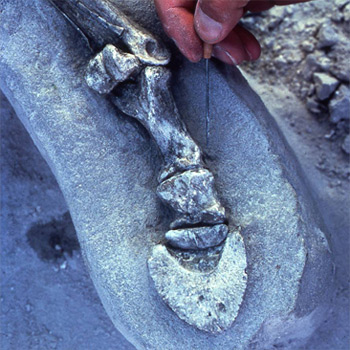Explore 3D models of fossils. Discover standards-based lesson plans for the classroom and the field. Examine supplementary materials from multiple sources that will enhance your Paleo Sleuth experience. Whether you're a learner seeking more details about a particular animal or scientist, or a teacher searching for instructor-ready presentations and hands-on activities that deepen understanding and complement the “Paleo Sleuths” program, this is where you'll find the images, text, and links that can help you uncover answers as well as raise new questions.
This is an introductory inquiry activity where students carry out investigations, record data, and ask questions to build relationships between evidence and explanations. This activity can be used to build background knowledge about science and engineering investigative processes.
This activity introduces students to a variety of fossils: large animal bones, small fragment pieces, and microfossils. Students will analyze fossils like that of a field paleontologist by drawing and describing their observations. Students will begin to understand that by investigating fossils, a broader history emerges to tell the story about what inhabited the Earth, the landforms and seas that existed, and that the tiniest of fossils, microfossils, can reveal more evidence through scientific research about Earth's climate history.

In this activity, students in groups of three will construct a vertical representation of a Geologic Time Scale and research facts, events, and organisms that differentiate between Time Scale Eras, Periods, and Epochs.
Paleo Sleuth Investigations, or PSI, includes four activities to be used in succession that focus around fossils in Nebraska and the Ashfall Fossil Beds State Historical Park located north of Royal, Nebraska. Each PSI engages students to explore fossils, the work of paleontologists in discovering, analyzing, and recording fossil evidence, and the environmental conditions of the earth at the time of fossil deposition.
This is an inquiry activity that will introduce students to the variety of fossils that can be found at Ashfall Fossil Beds State Historical Park located north of Royal, Nebraska. Students will use what they have learned about describing fossils from previous activities to infer information, and identify cardstock representations of fossils to that of the real fossils found at Ashfall through research on the Ashfall website. Students will have four excavation opportunities to investigate and identify the animals at Ashfall. This activity takes 1-2 days to complete. This activity is an adaptation of the Great Fossil Find.
Students, as preparators, will make a fossil field jacket using a seashell fossil. Seashells are used because they are larger to manage for this activity and can be ordered in a larger quantity. Other fossils or rocks can be used depending on the size. Palm size is recommended. They will only cover the topside of the seashell fossil or other fossil in this activity.
https://net.pbslearningmedia.org/collection/paleo-sleuths-digging-deeper/
